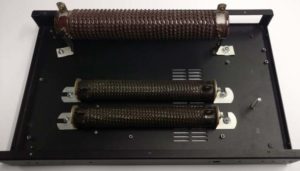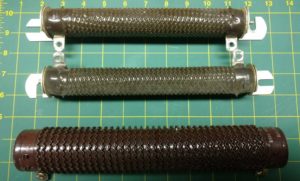In the past only relative low power loads have been needed for the evaluation of monolithic class D amp chips as they are typically 25 watts and under. Now working with some 200W (8 ohms) – 400W (4 ohms) amps and beefier load resistors are needed. The following little parts are now on the bench:
Found these online for quite a bit less than new parts, and as these were pulled from equipment came with an authentic layer of dust. The two smaller ones are 8 ohm 300W parts, the larger one is 4 ohms and somewhere in tho 400 to 500 W range. The part number on the 4 ohm can’t be crossed to anything, but based on the physical size it matches it up to something more or less equivalent.
The purist will note that since these are wirewound parts they will have some inductance, which was measured to make sure it’s not excessive. The 8 ohm parts were around 30 uH. Almost all real world speaker loads are inductive by an order of magnitude or two more than these resistors, and any sane modern amp is going to behave about the same between a pure resistive load and one that has a small reactive component (how it behaves with highly reactive loads is a different and very complex question). A future task though will be to compare the results with these parts and non-inductive load resistor to quantify the relationship; an initial look adding 500 uH of inductance to a resistive load on a class D amp degraded the measured THD+N by about 2 dB.
An old chassis pan and some plumbers tape for a mounting bracket for the 4 ohm one and it’s ready to go.

Amplifier THD+N tests using these parts showed an unexpected increase above a few watts of output power. Further investigation showed that the parts become non-linear above a certain applied voltage. The underlying cause of this was not investigated but it’s hypothesized that it’s due to the construction of the resistor, most likely the bonding between the wire element and the terminals. This effect has been observed in other recently purchased parts as well (though could of course be attributed so some other cause, though the symptoms appear to match).
Details of the investigation can be found here: ![]() PowerResistorTest.r3 (pdf file)
PowerResistorTest.r3 (pdf file)
The resistors will work fine for amplifier burn in under load and measurements other than THD+N.
Many people use the Parts Express load resistors, however the most recent batch (Jan 2018) of those has shown that they have a new vendor and the parts exhibit problems similar to the wire wound resistors tested here. Also the used wirewounds were about 1/3 the price of the Parts Express load resistors, so if they had worked out a load bank for a big multichannel amp was going to be made.
For a description of the solution to this problem see this post for low distortion amplifier loads.

